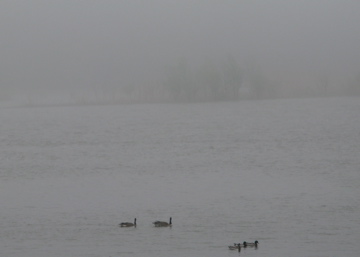Lost to the Lake: The Griffon - Lake Michigan's First Ghost Ship
The sinking of the Edmund Fitzgerald is the most famous maritime disaster in the history of the Great Lakes. However the fifteen hundred watery miles of the five lakes have claimed countless ships. Lake Michigan is especially difficult to navigate. Subject to rolling north winds that create hazardous waves, any vessel caught in a storm has little chance of finding refuge in Lake Michigan's few natural harbors. In addition, currents from the Straits of Mackinac combine with a shifting sandy coastline to increase the danger. And experienced sailors will confirm that the waves found on the Great Lakes are more unpredictable and sharper than those found on the ocean. Small wonder that so many ships and men have been lost to the lake.

The Griffon:
Lake Michigan’s First Ghost Ship
If you ever have the unsettling experience of plying through the waters of upper Lake Michigan as the fog rolls in, don’t be surprised to encounter a three masted old-time sailing ship coming dangerously close. It might be the ghostly crew of the lost Griffon searching for a safe harbor. While many ghost ships are reported to be still sailing the Great Lakes, the 17th century Griffon bears the distinction of being the first.
Built in 1679 by French explorer Rene de La Salle, the 40-ton Griffon was the first European ship to sail the upper Great Lakes. A true ‘wilderness vessel’, the Griffon was not a shipyard project; it was built instead along the banks of the Niagara River, several miles north of the American side of the Falls. Although the Griffon was fitted out with weaponry, her stated purpose was to deliver supplies for La Salle’s expeditions into New France.
Setting sail August 7, 1679 with LaSalle onboard, the Griffon left Niagara for Detroit where several men joined the crew. The difficult maiden voyage took the Griffon from Lake Erie to St. Ignace through the Straits of Mackinac and into Lake Michigan. It anchored finally off the shore of Green Bay, Wisconsin (present-day Washington Harbor). Soon afterward, LaSalle decided to send the Griffon back to Niagara in order to pick up men and supplies.
Carrying a cargo of furs, the Griffon set sail on September 18, 1679 under favorable weather conditions. Once they left Washington Harbor however, the ship and her crew of six were never seen again. The Griffon disappeared without a trace.
Rumors soon spread about the fate of the Griffon. Some believed that the Iroquois prophet Metiomek, who regarded the ship as a threat to the Great Spirit, put a curse on the ship. Metiomek is said to have warned LaSalle that the Griffon was doomed to sink to the bottom of the lake. The validity of this curse took on new meaning when Metiomek also predicted that LaSalle’s blood would cover the hands of those he trusted. In 1687, that prophecy seemed to be fulfilled when LaSalle’s own men mutinied during an expedition, and he was murdered by Pierre Duhaut.
As for what really happened to the Griffon, it very likely went down in a storm. The day after the ship set sail from Washington Harbor, a severe storm is recorded to have hit the area. The Great Lakes are home to countless wrecked ships that couldn’t withstand the white squalls and fierce weather that affect these waters. Between 1878-1898 alone, the U.S. Commissioner of Navigation reported nearly 6000 shipwrecks in the Great Lakes. Given that lake storms rival oceanic storms in strength and unpredictability, it is safe to assume that the ill-fated Griffon is almost certainly at the bottom of Lake Michigan.
For centuries, sailors on Lake Michigan have claimed to see the ghostly outlines of an antiquated ship emerge suddenly out of a fog bank. But just when the ships seem about to collide, the Griffon vanishes. Others swear that the Griffon can be glimpsed on foggy nights still sailing out of Green Bay Harbor. Not surprisingly, sighting the lost Griffon is regarded as a sign of bad luck.
Many people however are more interested in the actual ship, not the phantom one. Underwater explorers and archaeologists still search the waters of northern Lake Michigan for signs of the Griffon. In 2001, amateur explorer Stephen Libert found the remains of a ship while diving near Poverty Island. This discovery led to the involvement of the curator of Chicago’s Field Museum, Scott Demel, who describes the lost Griffon as “The Holy Grail of the Great Lakes”. Although Demel and Libert later took carbon samples from the site, legal battles over salvage rights currently prevent further exploration. Libert subsequently formed the Great Lakes Exploration Group, LLC in order to protect this possibly historic discovery. For more information, go to www.lasalle-griffon.org.
Whatever the outcome of the search for the missing vessel, the Griffon will always be remembered as the first European ship to sail – and haunt -- the waters of Lake Michigan.
---Sharon Pisacreta, © Sept. 2010
For further information on the Griffon:
Hauntings and Horrors, Daniel Cohen, 2002.
The Ghosts of Door County, Geri Rider, 1992
Haunted Lake Michigan, Frederick Stonehouse, 2006.
Mystery of Great Lakes Oldest Shipwreck, Peggy Walsh-Sarnecki, 2005.
(News article cited from WZZM13.com)
October/November 2010